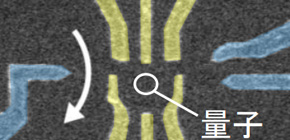
Successful single-shot readout of multiple two-electron spin states
A step toward high-speed and high-capacity spin-based information processing
Quantum information processing that conducts information transmission and computation based on quantum mechanics is drawing attention as next-generation information processing technology for realizing absolutely safe communication and computation that exceeds the performance of supercomputers. Currently, various quantum systems for achieving this are being studied around the world. One of these systems is one using spin, a magnet-like property.
The spin of a single electron confined in a quantum dot (QD) is promising matter for quantum information processing. Currently basic technologies, such as controlling spin states and integrating QDs, are rapidly being developed. Spins when multiple electrons are present can also be used for processing quantum information. There are two kinds of spin of an electron, and the number of spin states increases as the number of electrons increases.
It is theoretically predicted that as the number of spin states increases, the number of steps necessary for computation will decrease, which increases the amount of information that can be expressed by spin. However, as single-shot readout of spin states was limited to two types of spin states, studies were primarily performed on two spin states. Of the four types of spin states that two electrons could have, readout of only two-electron spin states was available.
A group of researchers led by Assistant Professor KIYAMA Haruki and Professor OOIWA Akira at The Institute of Scientific and Industrial Research, Osaka University, and Professor TARUCHA Seigo , Graduate School of Engineering, The University of Tokyo, succeeded in single-shot readout of three states that two electrons in a QD could have.
This group established a method of single-shot readout of the other two spin states in gate-defined gallium arsenide (GaAs) QDs using a quantum Hall effect. With this method, single-shot readout of spin states, which was different from ones obtained by existing readout schemes, was available. Thus, by using this method in combination with existing ones, this group succeeded in ternary single-shot readout of two-electron spin states. This group was also able to assess time for keeping spin information by observing hourly fluctuations of each spin status by using this single-shot ternary readout of two-electron spin states.
This group’s achievements have made it possible to conduct basic research for using three types of spin states, which will lead to the application to processing of large quantum information at high speed. QDs can be made from various material. For example, QDs made from silicon have an advantage of retaining spin information for a long time. The single-shot readout method developed by this group can be used for various materials including silicon.
This study verified a new concept of readout of multiple spin states by using different methods in combination, a world first. This will become a guideline for research and development of methods for single-shot ternary readout of more than two-electron spin states. It will open the way to new large-scale quantum information processing at high speed.
Abstract
We report on the single-shot readout of three two-electron spin states—a singlet and two triplet substates— whose z components of spin angular momentum are 0 and +1, in a gate-defined GaAs single quantum dot. The three spin states are distinguished by detecting spin-dependent tunnel rates that arise from two mechanisms: spin filtering by spin-resolved edge states and spin-orbital correlation with orbital-dependent tunneling. The three states form one ground state and two excited states, and we observe the spin relaxation dynamics among the three spin states.

Figure1. Comparison between binary spin readout and ternary spin readout.

Figure2. Scanning electron microscope image of the quantum dot used in this research. We formed the quantum dot by applying voltage to surface gate electrodes. Electron spin states can be read out by measuring the electric current flowing nearby the dot (white arrow).

Figure3. The results of binary spin readout using previous and new schemes, and that of ternary spin readout by combining these two binary-readout schemes.
To learn more about this research, please view the full research report entitled “ Single-shot ternary readout of two-electron spin states in a quantum dot using spin filtering by quantum Hall edge states ” at this page of the Physical Review Letters website.
Related link
